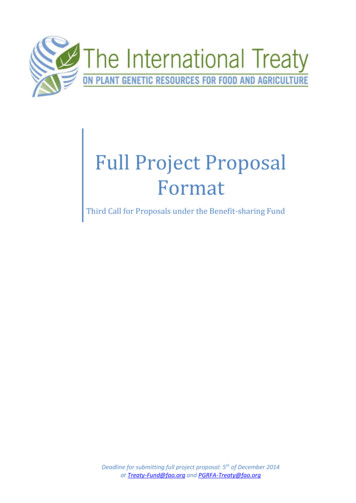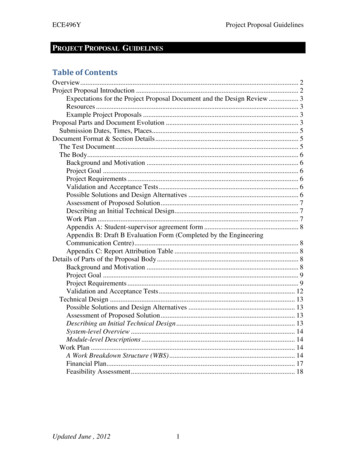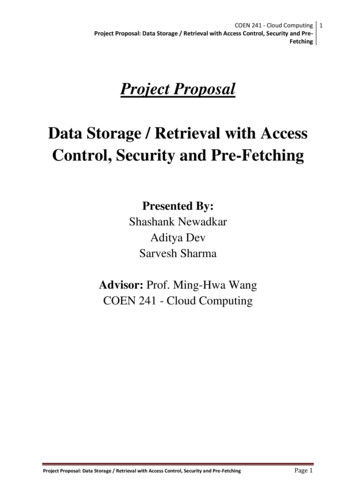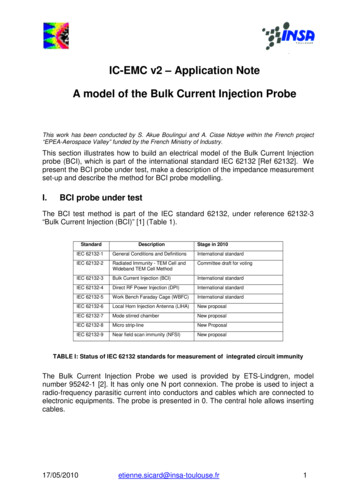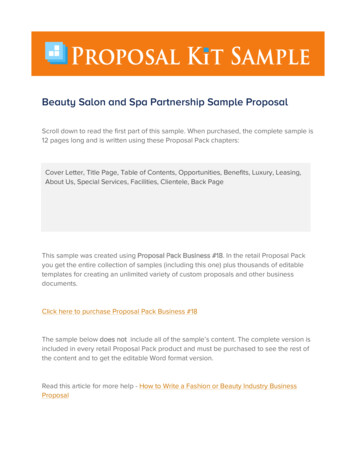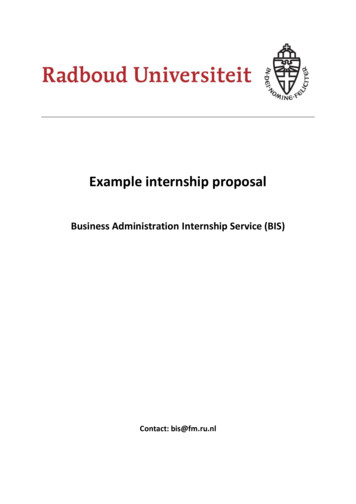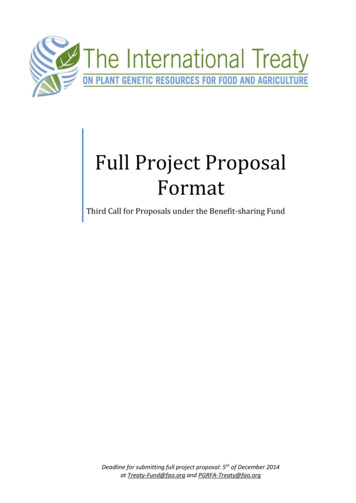
Transcription
Full Project ProposalFormatThird Call for Proposals under the Benefit-sharing FundDeadline for submitting full project proposal: 5th of December 2014at Treaty-Fund@fao.org and PGRFA-Treaty@fao.org
Third Call for Proposals of the Benefit-sharing Fund: Guidelines for the development of full project proposalsTABLE OF CONTENTSProject Proposal cover sheetGeneral requirementsSECTION A: EXECUTIVE SUMMARY1.1.Executive summarySECTION B: PROJECT DESCRIPTION AND CONTENTS2.1. Problem definition2.2. Overall and specific objectives2.3. Targeted outputs, activities and related methodology of implementation2.4. Targeted PGRFA2.5. Direct and indirect beneficiaries2.6. Impact and impact pathways2.6 1. Food security and poverty alleviation2.6.2. Adaptation to climate change and environmental sustainability2.6.3. Scientific impact2.6.4. Capacity development and empowerment2.7. Relevance to national or regional priorities in its plans and programmes for PGRFASECTION C: OPERATIONS3.1. Methodology of project implementation3.2. Partnerships and collaboration arrangements3.3. Project management team3.4. SustainabilitySECTION D: APPENDIXESAppendix:1 Information on the applicantAppendix 2: Logical FrameworkAppendix 3: WorkplanAppendix 4: BudgetAppendix 5: Disbursement informationPage 1
Third Call for Proposals of the Benefit-sharing Fund: Guidelines for the development of full project proposalsPROJECT PROPOSAL COVER SHEETProject No.(For Treaty use. Do not write anything here)Project Title:An Integrated Approach to Identify and Characterize ClimateResilient Wheat for the West Asia and North Africa RegionProject duration:36 MonthsTarget crops:Wheat (Triticum spp.)Targeted developing country/ies:, Egypt, Ethiopia, Jordan and SudanOther Contracting Party/ies involved:Ethiopian Institute of Agricultural Research (EIAR)- Ethiopia, National Center forAgricultural Research and Extension (NCARE)- Jordan, Agriculture Research Center(ARC)- Egypt, Agricultural Research Corporation (ARC)- SudanProject geographic extension (km²): 296,540.Total requested funding: 500,000 Total co-funding: 500,000 Please select the type of project you are applying for:Single-country Immediate Action Project (Window 2)Multi-country Immediate Action Programme (Window 2)Single-country Co-development and Transfer of Technology project (Window 3)Multi-country Co-development and Transfer of Technology project (Window 3)ApplicantName of Organization: International Center for Agricultural Research in the Dry Areas(ICARDA)Type of organization: CGIAR CenterProject Contact: (name and position): Dr. Ayed Al-Abdallat, Senior BiotechnologistE-mail address: a.al-abdallat@cgiar.orgTelephone: 202-357-24358Fax: 202-357280992
Third Call for Proposals of the Benefit-sharing Fund: Guidelines for the development of full project proposalsGENERAL REQUIREMENTSThese guidelines have been prepared to support applicants in the development of fullproject proposals. They describe the requirements that all applicants should adhere to whendeveloping their full project proposal.Please make sure you read these guidelines carefully before proceeding to fill in the ProjectProposal Form. The full proposal should be prepared taking into account the thematicfocus of the Third Call for Proposals, including in particular, the rationale, scope andexpected outputs for each Window and sub-Window.Project proposals must be clear and realistic on the problem to be addressed and objectivesit tries to achieve. Project objectives have to fit in the thematic focus of the call andultimately contribute to food security and poverty alleviation. Project objectives have to belogically interlinked with the planned activities, outputs and expected outcomes. Theobjectives and outputs have to be feasible in terms of duration and resources requested.The information to be provided in each section has to be focused and straightforward,qualitatively and quantitatively measurable in terms of what will be done, with whatpurpose, who, why and how will be involved in the activities to be implemented, who andhow many will directly and indirectly benefit from the implementation of the project. Agood full proposal will have a sound, clear and logically linked methodology ofimplementation and management.The full project proposal should contain no more than fifteen (15) pages of text(Appendixes, table of contents and cover sheets excluded). The number of pages allocatedto each section is a guide. The information required can be less but not more than the pagesstipulated. All Appendixes should be duly filled in according to the provided guidelines asthey form an integral part of the full project proposal. Project proposals lacking at least oneAppendix, will be excluded from the selection process. The Appendixes will be providedto you in separate files together with the present document.When submitting the full project proposal, additional attachments (endorsement letters,funding commitments, certification of the status of the organization) can be provided.Please ensure that the project proposal and all attachments are legible in Times NewRoman 12 and provided in two formats (pdf and word). Make sure the signature of theproject coordinator is put on the signature page.The project proposal, if approved for funding by the Bureau of the Sixth Session of theGoverning Body, will form an integral part of the contractual agreement (Letter ofAgreement) that will be signed with each applicant organization of the approved projects.3
Third Call for Proposals of the Benefit-sharing Fund: Guidelines for the development of full project proposalsSECTION A: EXECUTIVE SUMMARY1.Executive summaryClimate change is expected to cause adverse effects to agriculture around the globe, withmany countries showing increasing concerns about their possible devastating ripercussions.Earth temperatures are expected to increase by approximately 2 C in the next 100 years,which will result in dramtic changes in rainfall patterns in many parts of the world andparticularly in dry areas. Temperature and water availability are major determinants ofplant productivity. Limited water supply (drought stress) and warmer temperatures (heatstress) will certainly reduce crop production. Wheat yields are expected to drop byapproximately 5% at each 0.5 C increase in temperature.Wheat (Triticum aestivum L. and Triticum durum) is the third most cultivated crop on theplanet and the first for human uptake of dietary proteins and fibers (FAOSTAT 2012).Modern wheat cultivars were developed from a genetically narrow germplasm by means ofpedigree. This increased its vulnerability to climate change, stress, and diseases. Decreasein potential wheat yield due to climate change stresses is very likely the outcome of theinability of the modern variety to adapt to hotter and/or shorter growing periods andprolonged water deficit conditions and heat stress. Such conditions are already veryexplicit in most of the dry areas of the World, especially within West Asia and NorthAfrica (WANA) region. Furthermore, in most of the countries of WANA, wheatproduction is currently not sufficient to meet the rising domestic demands by the growingpopulations. Millions of tons of grain are imported annually to satisfy these needs, whichraises the question of what will happen when climate change will cause a reduction in theglobal production and therefore to the exportations.Wheat landraces, with high level of adaptation to drought and heat stresses, are rapidlydisappearing from the main wheat production areas in the targeted countries and arereplaced by new genetically uniform cultivars. Therefore, there is an urgent need to collectsuch wheat material and to characterize it at the molecular and phenotypic levels to enabletheir utilization in future breeding strategies to cope with climate change. Collected wheatgenetic material deposited in ICARDA and national genebanks is not fully exploited (lessthan 8% are utilized) and their potential as a source of new alleles for breeding for droughtand heat stress tolerance is not fully utilized. Therefore, there is a need to study thedurability and variability in such material, which have been selected over millennia andthat might be adapted to local harsh environments. This will lead to the identification ofnew alleles for tolerance against drought and heat stress, which will be utilized inICARDA and National Agricultural Research Systems (NARS) breeding programs.In this study, an integrated approach that includes different molecular, phenotypic andinformatics tools, will be adopted to identify and characterize wheat genetic resourcesresilient to climate change with special emphasis on drought and heat stresses. The studywill seek the establishment of an effective long-lasting partnership between ICARDA, as aleading institute, and NARS in targeted countries. This will provide the breeders and otherscientists at ICARDA and NARS with the proper tools to share and integrate phenotypicand genetic information to accelerate the delivery of new wheat varieties that are adaptedto the climate change-related challenges with particular emphasis on informationexchange, technology transfer and capacity-building.4
Third Call for Proposals of the Benefit-sharing Fund: Guidelines for the development of full project proposalsSECTION B: PROJECT DESCRIPTION AND CONTENTS2.1. Problem definitionClimate change and associated conditions are growing concerns affecting many regionsand earth temperature is expected to increase causing changes in rainfall patterns in manyparts of the world (Thornton et al., 2014). The worst climate change scenarios envisagemajor impact on food production and food insecurity implying direct effects on agriculturein many countries around the globe (Challinor et al., 2014). In West Asia and North Africa(WANA) region, the dryland farming systems are expected to be severely affected byclimate change (Thomas 2008) and projected to reduce renewable surafce and groundwater reseources with inceased temperature in most dry regions (IPCC, 2014).Temperature and water availability are major determinants of plant productivity and, underclimate change, limited water supply and warmer temperatures will most probably reducethe yield of any given crop. Such new conditions, associated with climate change, willhave major negative impacts on crop productivity of many cereal crops, including wheat,adding more suffering to the growing populations and poor-resource farmers in dry areas.The WANA region is considered among the largest food-deficit regions in the world wherelarge scale importation of grains, particularly wheat, is common. Future scenarios predictan increased dependency on food importation, thus worsening the food security situation inthe region. Besides, countries with high population growth rates will face natural resourcedegradation resulting in facing high rates of food insecurity. Taking Ethiopia as anexample, the country is among the poorest countries in the world, with a per capita incomeof 470. Approximately 40 percent of the population still lives below the poverty line andlife expectancy of the population at birth is only 56.19 years (World Bank 2014). Toimprove the food security in the country, there are governmental plans to expand wheatcultivation into new areas across the country. However, growing wheat in such areas willrequire cultivating high yielding and drought and heat tolerant varieties. Similar plans arebeing made by Egyptian government to boost wheat production in the new valley andToshka areas in southern parts of Egypt. Such areas are prone to climate change associatedconditions, particularly drought and heat stress. In Sudan, which imports 80 percent of itsannual wheat needs, there are plans to boost wheat production by increasing the cultivatedarea. Climate change scenarios estimate a crop yield reduction in Sudan by over 20% dueto heat stress (Jones and Thornton, 2003). Based on the water stress index (the value ofannual rainfall divided by total population), the availability of water in Jordan is classifiedas “absolute scarcity” (Mudabber, 2007). The impacts of dry conditions associated withclimate change on rainfed agriculture in Jordan is clear and include the complete failure ofcrops in the field and increased cost of providing extra feed to animals on smallholderfarmers. Drought will affect the dryland mixed systems by excluding wheat and replacingit with other crops.Many models predict that climate change will have major negative effects on wheatproduction areas, especially in the WANA region (Habash et al., 2009). This reduction inyield is expected due to temperature increase, uneven distribution of rainfall and the shifttoward short growing seasons. Therefore, a major challenge for wheat improvement inWANA region is how to plan for future climate change worst scenarios. Under climatechange conditions, wheat plant will require complex tolerances to the extreme pressures ofdrought and heat (Habash et al., 2009). In a recent study, a process-based model to predictwheat adaption to the detrimental effect of climate change indicted that the negative impacton yield through climate change would be decreased and mitigated due to the adoption ofnew short growing and faster maturating varieties with enhanced tolerance to drought andheat stresses (Semenov et al., 2014). In another recent study, a data set based on more than5
Third Call for Proposals of the Benefit-sharing Fund: Guidelines for the development of full project proposals1700 simulation models indicates a negative impact of climate change on wheat yield indifferent regions around the globe if no adaptation measurements are considered (Challinoret al., 2014). However, the same data set predicts a yield increase, 8 to 15%, if moreeffective climate change adaptive varieties were developed. Therefore, tolerance to heatand drought stresses should remain a priority for the genetic improvement of wheat in dryareas.Under climate change conditions, the adaptation of new wheat varieties is needed to copewith yield reduction associated with heat and drought stresses. To cope with these newconditions, there is a need to breed for new high yielding wheat varieties with improvedresilience to climate change and particularly drought and heat stress. Efficient and effectivegenotypes with a short growing season and tolerance to major abiotic stresses should beutilized to produce new improved cultivars with enhanced productivity to overcome theadverse effects of climate change (Semenov and Halford, 2009). Therefore, improving andupgrading capacities of current wheat breeding programs at ICARDA and NARS inWANA region through the utilization of wheat genetic resources and modern molecularbreeding tools are required to accelerate the delivery of such varieties. In addition, breedersneed to use techniques from single selection to complex molecular methods to integratedesirable traits into existing varieties to improve wheat productivity in production areasvulnerable to climate change (Araus, et al., 2008). Out-scaling current selectiontechnologies to national partners through training will help breeders select new materialwith desired traits for their programs.Based on the frame conditions and challenges encountered due to climate change, theproposed study will focus on new emerging technologies and information tools to utilizegenetic resources for the benefits of gene banks and wheat breeding programs in WANAregion. This project will provide the breeders and other plant scientists, as directbeneficiaries, at ICARDA and NARS with the proper tools, and phenotypic and geneticinformation to accelerate the delivery of new wheat varieties that are adapted to theclimate-related challenges in WANA regions. Furthermore, the proposed study will utilizeplant genetic resources from ICARDA and national wheat breeding programs in WANAregion besides the identification of putative wheat genetic resources at ICARDA, NARSand other gene banks that are resilient to climate change associated stresses (with particularemphasis on drought and heat tolerance) using the Focused Identification of GermplasmStrategy (FIGS) aligned with WANA geographical and climatic data available from thenewly developed ICARDA Geoinformatics Portal (http://geoagro.icarda.org/).This special set of wheat germplasm (elite lines, breeding material and landraces) will beassembled and managed by the ICARDA gene bank team and will be subject to geneticdiversity analysis using a defined set of SNP markers ( 50 markers) that will includealready developed diagnostic markers for major agronomical traits (plant height, floweringtime) and major pathogens resistance genes (rusts). Two selected subsets of a total of 250durum and 250 bread wheat accessions will be evaluated in research stations in thetargeted countries for their performance under heat and drought field conditions. Toidentify marker associations with heat and drought tolerance, the two subsets will begenotyped with a suitable robust and high-density SNP genotyping platform. The identifiedclimate change resilient wheat lines and the molecular data of SNP markers associatedwith improved performance under heat and drought tolerance in targeted areas will bemade available to the national program for future breeding applications.In addition, all genotypic, phenotypic, collection sites and related data of the characterizedwheat material will be integrated and used to develop a web-based tool to help ICARDAand national programs and scientists in WANA region to facilitate future selection in theirbreeding programs. The new database will be designed as an open access for data(molecular and phenotypic) sharing and deposition to the benefits of all national6
Third Call for Proposals of the Benefit-sharing Fund: Guidelines for the development of full project proposalsinstitutions in the region and the world (taking into consideration the legislation andregulations regarding intellectual property protection) with options to enable new datadeposition and linkage with other existing platforms.Finally, the proposed study will include a capacity development component includingtraining of human resources from the key national partners on the use of molecular markersin wheat breeding programs (with special emphasis on new genotyping technologies forlarge scale analysis) and the resulted information management systems beside alreadyexisting gene bank management systems.2.2. Project objectives: Overall and specific objectivesThe overall goal of this study is to identify and characterize climate-resilient wheatgermplasm that can be used to develop high yielding varieties with improved adaptation tothe drought and stress conditions prevalent in the WANA region.The identification and utilization of PGRFA to develop new wheat lines with improvedtolerance to drought and heat stress conditions prevalent in WANA region is needed forbetter food security and sustainable productivity. This will eventually improve theproductivity of wheat in the targeted region, increase the livelihood of low incomecommunities and resource-poor framers in WANA region and contributes to food securityin targeted countries.In addition, the proposed study aims to enhance the current capacities of NARS breeders,to promote partnerships and participation and to ensure knowledge sharing with the wheatscientists in the region.The project specific objectives are:1- To evaluate a large collection of genebank accessions for two years, under contrastingdrought and heat field conditions.2- To identify novel wheat genetic material with improved tolerance to drought and heatstresses.3- To identify useful alleles for breeding drought and heat stress tolerance by means ofassociation mapping.4- To use molecular markers for simplifying the transfer of useful alleles associated withdrought and heat tolerance into ICARDA and national breeding programs.5- To improve the current capacities of the conventional wheat breeding programs in theregion by using cutting-edge molecular and breeding tools.6- To develop a web-based tool for integrating data at the accession level with genomicand phenotypic information with accessibility to all institutions in WANA region.7- To provide training courses in targeted countries, workshops and scientific publications.2.3 Targeted outputs, activities and related methodology of implementationOutput 1: Climate change resilient wheat genetic resources with improved tolerance todrought and heat stress are identified and conserved.Target: Assembly of a wheat genetic resources special set that include climate resilient,drought and heat stress tolerance wheat accessions and germplasm fromICARDA and NARS breeding programs and gene banks.7
Third Call for Proposals of the Benefit-sharing Fund: Guidelines for the development of full project proposalsActivities:1.Identification and multiplication of wheat accessions from drought and heat stressprone areas using an improved FIGS approach.2.Utilization of wheat breeding material and populations from ICARDA,international and national breeding programs.Outcomes: 1250 diverse wheat accessions are characterized, multiplied and conserved.Output 2: Two diverse subsets that include climate resilient, drought and heat stresstolerance durum and bread wheat genotypes identified using improved FIGSand modern genomics tools.Target: Genetic diversity and population structure analysis of the wheat special set usingdiagnostic SNP markers linked to growth habit, plant height and other relatedtraits to produce two subsets (bread and durum wheat).Activities:1.Testing 50 SNP markers on 1250 wheat accessions from the special collectionset using the KASP genotyping assays.2.Genetic diversity and population structure analysis to produce two subsets for breadand durum wheat genotypes for genome wide association mapping studies.Outcomes: Two subsets for bread and durum wheat that contain at least 250 diverse wheataccessions per species are characterized using molecular markers available.Output 3: Field evaluation of the two subsets for yield potential and stability underdrought and heat stress conditions.Target:Identification of wheat lines with improved tolerance against drought and heatstress and phenotypic data to execute a genome wide association study.Activities:1.Evaluation of the two AM panels (250 for each species) for their performanceunder drought and heat stress conditions.2.Phenotypic data collection and analysis for major yield and yield components traitsassociated with drought and heat stress tolerance in the two panels.Outcomes: Phenotypic data for the field performance of the two subsets under drought andheat stress tolerance available.Identification of at least 20 wheat lines from each species with improvedtolerance against drought and heat stress.Output 4: New alleles for drought and heat tolerance in the two subsets are identifiedusing a genome wide association mapping approach.Target:Identification of molecular markers linked to traits conferring drought and heatstress tolerance in the two subsets.Activities:1.Genotyping of the two subsets using high-throughput SNP genotyping systems.2.Genome wide association mapping analysis using genotypic and phenotypic datafrom the field evaluation experiments.Outcomes: Identification of at least 10 QTLs against drought and heat stress in each subset.Output 5: Existing and newly developed SNP markers for selected agronomical traits, andabiotic stress tolerance are utilized in ICARDA and NARS wheat breeding.Target:Marker assisted selection using high-throughput genotyping platforms aredeployed in ICARDA and NARS breeding programs.Activities:1.Conversion of at least 10 SNP markers associated with drought and heat stresstolerance into KASP assays.8
Third Call for Proposals of the Benefit-sharing Fund: Guidelines for the development of full project proposals2.Screening at least 500 lines from ICARDA and NARS wheat (durum and bread)breeding programs using at least 20 SNP markers associated with drought and heattolerance through the KASP genotyping assays.Outcomes: Implementation of a marker assisted selection system for selected traits inICARDA and NARS breeding programs using SNP markers and highthroughput genotyping platforms.Note:The activities of this particular output might be extended after the end of thethird year (year four in Appendix 3) as a continuity of impact operations of theproposed study.Output 6: Open access integrated database with accession passport information, genomicsand phenotypic dataTarget:Development of user friendly web-based tools to facilitate data and informationexchange between participants.Activities:1.Database development and incorporation of field and molecular data, results andmarkers information for wheat material used in this study.2.Database made available online at ICARDA web site for public.Outcomes: Facilitate information exchange and data use between the collaboratinginstitutions and for scientific, technical and environmental matters related toplant genetic resources and climate change in WANA region is available.Output 7: Increased capacity of NARS institutions and breeders in WANA region to usemolecular markers to breed climate change resilient wheat.Target:At least 20 NARS breeders and scientists (disaggregated by gender) fromparticipating countries trained on genetic resources management, breeding andmolecular tools using SNP markers and bioinformatics.Activities:1.Training courses targeting NARS scientists and breeders to acquire skills inspecific areas of molecular breeding.2.A workshop on the use of web-based tools for breeding activities.Outcomes: Increased capacity of NARS institutions and breeders on using molecularmarkers for breeding climate change resilient wheat varieties.2.4. Targeted PGRFAThe targeted PGRFA in this proposed study is wheat (Triticum spp.). Special emphasis willbe mainly given on bread (Triticum aestivum) and durum wheat (Triticum durum) thathave potential to harbor new alleles for drought and heat tolerance as inferred by the FIGSapproach and molecular work. The used material in the special collection set ( 1250accessions) and the two subsets (bread: 250 and durum: 250 accessions) are expected tocontain gene bank accessions, prebreeding material, historical and elite breeding linesmaintained at ICARDA genetic resources unit and breeding programs. Besides, newlyreleased varieties by ICARDA and NARS of the targeted countries will be used in theimplementation of the proposed study. The utilization of wheat germplasm in futurebreeding activities might result in the production of wheat varieties with improvedtolerance against heat and drought that can be used by NARS for wheat improvement andto achieve better food security for poor-resources population groups in WANA region.Any material obtained from this project will be conserved in ICARDA gene bank.Furthermore, phenotypic and genetics information related to the tested material will bemade available through the online database at ICARDA web site.9
Third Call for Proposals of the Benefit-sharing Fund: Guidelines for the development of full project proposals2.5. Direct and indirect beneficiariesWheat germplasm identified in this study will directly benefit ICARDA and nationalpartners’ wheat breeders in WANA region. Training targeting young scientists andbreeders from the selected countries and the development of data sharing tools will allowdirect technology transfer and wider access to information that will help breeders improvewheat production in WANA region. The training of breeders, scientists and extensionpersonnel will ensure equality and gender representation. We are expecting that at least 20NARS breeders and scientists will directly benefit from the training courses andworkshops.In addition, the scientific community will have access to the results from this project thatwill facilitate the utilization of the characterized wheat germplasm for other studies. Weanticipate that hundreds of breeders and wheat scientists will access the web site on annualbasisThe utilization of climate resilient wheat germplasm to develop improved drought and heattolerant cultivars is expected to contribute to enhanced wheat production, food security intargeted countries and to the improvement of the livelihood of tens of thousands poorresources farmers in WANA region. The results will be presented to the NARS directors inthe targeted countries to promote the adoption of any newly released varieties with heatand drought tolerance in their future plans.Finally, the poor-resources farmers growing wheat under dryland environments will be theultimate beneficiaries of the results of this project.2.6. Impact and impact pathwaysThe project will contribute to to the achievement of Millennium Development Goals 1and 7: To eradicate extreme poverty and hunger Ensure environmental sustainability2.6.1. Food security and poverty alleviationAs mentioned earlier, one of the main objectives in the proposed study is todevelop new wheat lines with improved tolerance to drought and heat stressconditions prevalent in WANA region. The new wheat varieties could be utilizedby the NARS and resource-poor farmers in the WANA countries to increase theproduction of wheat to achieve better food security, reduce large scale importationof grains, and alleviate poverty resulting in better livelihood of poor-communities.In addition, the utilization of molecular markers in breeding programs will assist inaccelerating breeding cycles and precise selection of wheat material for differenttraits. This will assist in delivering wheat lines tailored with selected alleles andgenes for drought and heat stress tolerance, and other important traits such asdisease resistance, quality and agronomical performance.Furthermore, the outputs of the proposed study will align with
to each section is a guide. The information required can be less but not more than the pages stipulated. All Appendixes should be duly filled in according to the provided guidelines as they form an integral part of the full project proposal. Project proposals lacking at least one Appendix, will be excluded from the selection process.
